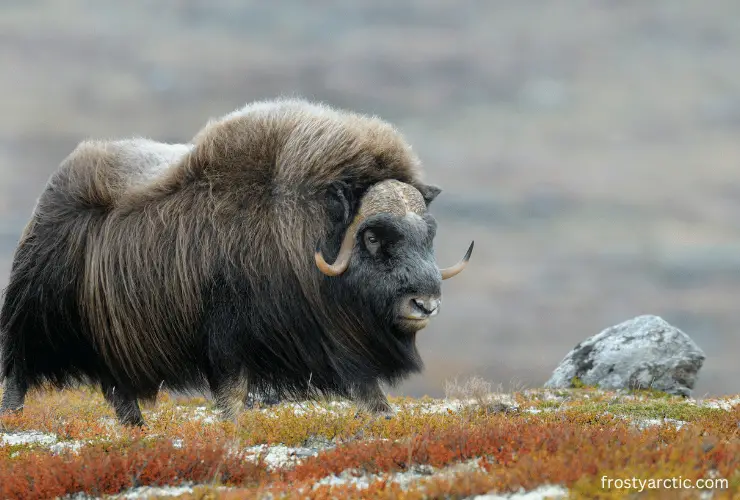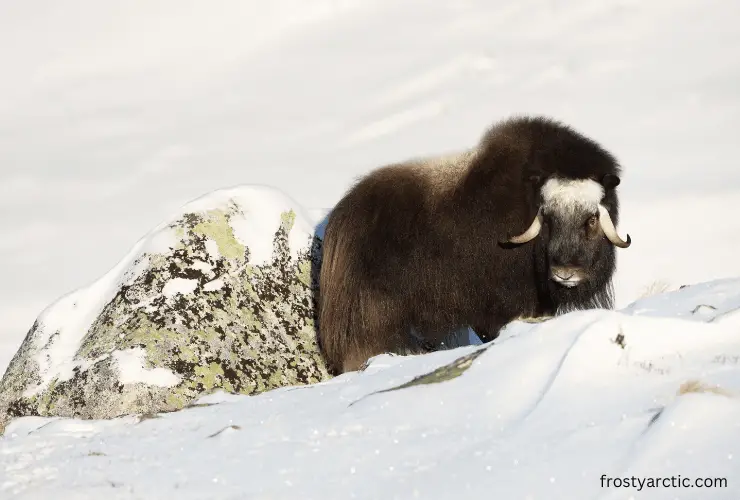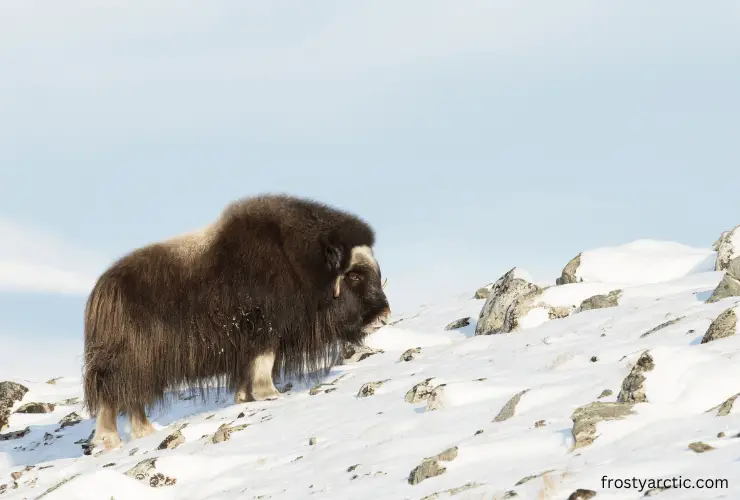Fortunately, Musk Oxen are neither endangered nor threatened to get endangered shortly. More than 1 lac Musk Oxen are there in the world, thus making it to the LEAST CONCERN category of the Red List by IUCN.
Although Musk Oxen aren’t endangered, various climatic changes and human activities stress their existence.
Want to learn how we are contributing to this increased stress? Then without any further ado, jump to the next section, as this article answers all your curiosity!
Are Musk Oxen Getting Endangered? The Total Percentage of Musk Ox
No!
Fortunately, Musk Oxen (Ovibos moschatus) are not among the endangered or extinct species.
However, they are facing issues like climate change, hunting, and habitat loss, in some areas of the world.
Therefore, various conversation problems and strategies are being worked out to develop the best solution for their protection.
The number of Musk Oxen in the world
How many Musk Oxen are there in the world presently? Nearly 80,000 to 135,000 Musk Oxen are present in the world currently. Out of these, a rough breakdown of their distribution is as follows:
- 80% is in China
- 15% in Greenland
- 4% in Alaska
- 1% in Russia
- A very small amount in Norway and Sweden
Major Factors That Lead to Musk Oxen Endangerment
Musk Oxen aren’t on the edge of getting endangered or so. However, multiple problems and contributing factors threaten their lives and can lead to extinction if not appropriately controlled. These include:
Climate Change
Climate Change impacts the growth and successful survival rate of Musk Oxen drastically. These include a rise in temperature, melting ice, loss of food, etc.

For example, Musk Oxen are adapted to live in the harsh environment of the Arctic Tundra. They can’t live in warmer areas. Similarly, an increase in temperature results in more rainfall. As a result, a snow layer covers the food, thus making animals’ excess to food more difficult.
Moreover, it results in a change in vegetation pattern and time. Earlier plant growth results in a mismatch of timings between Musk Oxen migration, food storage, and reproduction, ultimately resulting in chaos and reproductive stress.
Over hunting
Over-hunting is one of the prime factors that lead to endangerment. Unsustainable hunting of Musk Oxen to obtain their meat, fur, hides, and horns result in population decline and overharvest in certain areas.
It not only reduces population but also disrupts the social behavior of the herd and causes cascades in population dynamics.
Habitat loss
Human activities such as extensive mining operations, road constructions, pipeline introduction, etc., destroy the habitat of the Musk Ox. As a result, it becomes hard for them to find shelter and reduces the easy availability of food.
Diseases
Musk Oxen are known to have comparatively less strong immunity than other animals. Therefore, they should be kept at bay from encountering diseased animals.
Diseases play a crucial role in endangering Musk Oxen by causing mortality and mating reduction, thus leading to reduced reproduction.
Inbreeding
Inbreeding also results in the endangerment of Musk Oxen by resulting in
- Loss of genetic variability and diversity
- Increased risk of transmission of diseases and harmful genes
- Increased risk of getting exposed to the same environmental stressors
- Decreased fertility and reproducibility rate
What is the Musk Oxen Conservation Project?
Musk Oxen Conservation Projects are an attempt to protect the population of Musk Oxen, increase awareness about their importance, improve their living conditions, and come up with some practical solutions to ensure the successful survival of these Arctic Oxen.

Several Musk Oxen Conservation Projects are currently working around the world. A few known ones include
Musk Ox Farm in Alaska
It is a non-profit conservation organization that started in 1954 when the Musk Ox was at the peak of becoming extinct in Alaska. The team reintroduced the animals to Alaska and all areas where Musk Oxen previously lived.
Nunavut Muskox Management Plan in Canada
It is a comprehensive strategy developed in 2008 by the government of Nunavut to manage the Musk Ox population, distribute them evenly, monitor them, and design programs to protect their habits.
Greenland Muskox Project
It is a project introduced by the University of Copenhagen that aims to study the interaction and behavior of Musk Oxen with other animals and their response to changed climate conditions. Later, they come up with ways to improve their survival chances.

Where Is Musk Oxen Categorized in The Red List Of IUCN?
The red list by the International Union for Conservation of Nature is a criterion to judge the conservation status of wildlife. They are categorized into various groups ranging from critically endangered to least concerned.
Fortunately, Musk Oxen are present in the “Least Concern” area.
Frequently Asked Questions (FAQs)
Are you allowed to hunt a Musk Ox?
Yes!
One can hunt a Musk Ox as long as they have a permit license. However, there are some rules and regulations that you need to follow. These include license by managing authority of that area, type of weapon, handling, and many more.
Moreover, in some parts of the United States, you aren’t allowed to hunt them due to the threat of being endangered.
Is Musk Ox extinct in Alaska?
No!
Musk Oxen are not extinct in Alaska. In fact, they are native to it.
However, back in the 1900s, they were known to be at the edge of extinction due to excess hunting, climate change, and food storage.
There was a time when less than 100 Musk Ox were present in Alaska. Then in 1920, a group of oxen was captured from Greenland and introduced in Alaska, but the efforts bore no fruits.
Later, in the 1950s, zoologists made another attempt at reintroduction which turned out to be quite successful in its outcomes. Read more.
Q.3 How long do Musk Oxen live?
Musk Oxen usually have a limited lifespan of 12 to 20 years. However, some oxen are known to live for 22 years or even more.
Final Words
To cut it short, Musk Oxen are neither extinct nor endangered animals. Various species of Musk Oxen are distributed in colder regions of the world, including the United States, Greenland, Alaska, Canada, and many more.
However, human activities are resulting in environmental stressors for Musk Ox. Therefore, various conservation projects are operating worldwide that aim to research and develop innovative ways to protect these Arctic oxen.



1 thought on “Are Musk Oxen Endangered?”